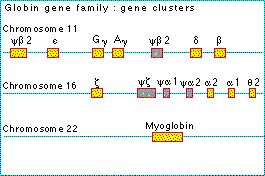Gene clusters

Many genes are arranged along the chromosomes in groups of related genes. These groups are called gene clusters. Related genes may be arranged in more than one physical cluster and a whole set of related genes is called a gene family. Gene clusters and gene families vary in importance in different taxonomic groups; they seem to be much rarer, for example, in insects than in mammals.
Examples of gene clusters are the globin gene family.
• The hemoglobin molecule that transports oxygen in the blood is made up of a number of components. Human hemoglobin is a tetramer: in adults it is made up of two alpha globins and two beta globins; in the fetus, of two alpha and two g globins; and in the embryo, two e and two z globins. The sequences of these five globin types are similar and the genes that code for them occur in clusters on the chromosomes. In humans, there are two main clusters of globin genes: the alpha globin cluster on chromosome 16 and the beta globin cluster on chromosome 11.
Gene clusters are probably formed by a process called duplication.
Figure: the globin gene family consists of a number of clusters of related genes. In humans, illustrated here, there are three clusters. In other species, the globin gene in each cluster and the distribution of the clusters through the chromosomes differs from humans.
| Next |



